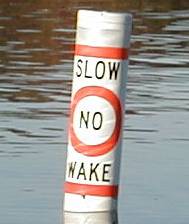Here’s an outline of the procedure used by a homeowners’ association to get approval to install No Wake buoys in several coves on the Campbell County portion of Leesville Lake. Bedford and Pittsylvania counties likely have different procedures, so it is best to check your county’s code and with your county administrator before seeking approval for No Wake buoys. It is best to contact your county administrator to tell him or her what you want to do and get specific information on what is required.
A request for approval of No Wake buoys must come from the property owners and must first be approved by county supervisors. If the development has a homeowners association (HOA), the HOA could submit the request on behalf of the property owners. The request should state the reason for the request, i.e. public safety, and include a map of the coves with the specific location of each no wake buoy (GPS coordinates).
Once the county supervisors approve the request, the request goes to the Virginia Department of Game and Inland Fisheries (VDGIF) for approval. It is best to work with VDGIF in advance to tell them what you want to do and where you want to place the buoys so that when the request for approval goes to VDGIF from the county, it would be readily approved. A point of contact with VDGIF is Lt. Chris Thomas in the Forest office: 1132 Thomas Jefferson Rd, Forest, VA 24551 (tel: 434-525-7522).
The anchoring system for the buoys is fairly simple. Make an anchor by putting 80 lbs of concrete in a 5 gal plastic bucket. Run 2 pieces of rebar about mid-way thru the bucket at 90 deg. angles and have rebar extend about a foot outside the bucket–that helps prevent the anchor from moving along the lake bottom. Put a stainless steel (SS) eye bolt with fender washers in the wet concrete. Although it is probably not necessary, run wire from the eye bolt/fender washers to the rebar before filling the bucket with concrete. Attach about 10 ft of 3/8″ SS cable to the bottom of the buoy and then run 1/2″ nylon rope from the cable end to the eye bolt on the anchor. A depth finder should be used to find the depth of the cove where the buoy will be placed to determine the length of nylon rope. Add a couple of extra feet of rope to be sure that there is enough rope to provide a little slack at full pond otherwise, the buoy will move.
It is important to ensure that the buoys stay in their approved location and that they are maintained in good condition. VDGIF periodically inspects the location and condition of the buoys. The county and VDGIF have authority to remove any buoys that are not properly located or not well maintained.

